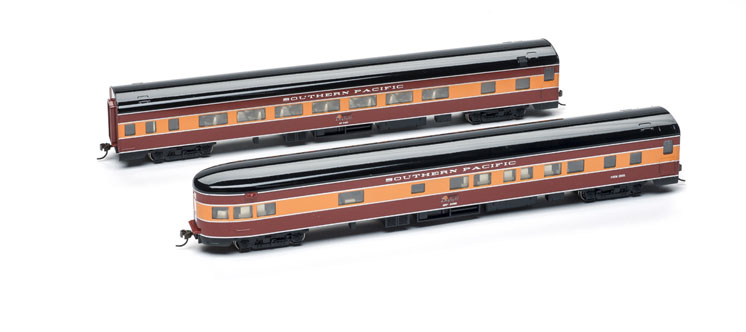A pair of smooth-side, full length, lighted passenger cars with interiors is new from Bachmann. The coach and observation are based on New York Central and Pennsylvania RR prototypes respectively, and are available in several paint schemes.
The prototypes. The coach is a near-match to a series of NYC 56-seat coaches built by American Car & Foundry in 1941. The 25-car order was numbered 2645 to 2669. Most of the cars lasted until Penn Central, with many cars going to New York City’s Metropolitan Transportation Authority in 1971.
The observation is very similar to a Pennsylvania RR class POS21A sleeper/lounge/observation built by Pullman-Standard in 1938 for the Broadway Limited and Liberty Limited. The cars were retired in 1960 and ’61.
The models. In HO scale, the coach is 85 feet long overall, 10 feet wide, and 13′-31⁄2″ tall. All dimensions are within inches of drawings of ACF lot 2141 cars on the Canada Southern website at www.canadasouthern.com. The window arrangement also matches the drawings.
The interior layout is similar to the drawings, except that the interior bulkheads are 1′-5″ too close together, and there are 48 seats instead of 56. The prototype’s trucks have a 9′-0″ wheelbase.
The observation’s length, width, and height are within a few inches of drawings in The Official Pullman-Standard Library: Vol. 4, Pennsylvania RR, by W. David Randall and William M. Ross (1988, Railway Production Classics).
The interior layout is missing sleeping compartment bulkheads – there should be two master rooms and one bedroom, but it’s a single open compartment. Also, the curved walls and seating areas are missing between the lounge and observation compartments.
The window arrangement matches PRR drawings on Rob’s Pennsy home page at www.prr.railfan.net, and the Pullman-Standard drawings, except the rear-most windows on the observation end of the car are about 6″ short, creating more space between the windows and the rear door than on the prototype. The trucks are the correct wheelbase.
Glazing is flush-mounted, creating a smooth outer surface. Diaphragms are solid molded-on details, as are all grab irons. Our samples were painted in Southern Pacific Daylight colors. The high-gloss paint was smoothly and evenly applied, with sharp color separations. Both cars are similar to some Southern Pacific smooth-side cars.
On the layout. The Bachmann smooth-side passenger cars had no trouble passing through the no. 6 turnouts of the Bay Junction yard on our Milwaukee, Racine & Troy staff layout. The cars also negotiated the Atlas Snap-Switches and 18″ radius curves on our Beer Line layout. The swinging coupler mounts helped the cars stay coupled around sharp curves.
Although these cars aren’t exact duplicates of their prototypes, they do share characteristics of many smooth-side cars, and would make fine stand-ins for many model railroads. If you’re in need of some smooth-side passenger cars, be sure to give these a look.
Price: $79 each
Manufacturer
Bachmann Industries Inc.
1400 E. Erie Ave.
Philadelphia, PA 19124
www.bachmanntrains.com
Era: 1938 to present, depending on paint
Roadnames: Coach: Southern Pacific, Baltimore & Ohio, Pennsylvania RR, Ringling Brothers & Barnum & Bailey Circus, Union Pacific. Observation: Southern Pacific, Baltimore & Ohio, Pennsylvania RR, Union Pacific. Both available painted silver, unlettered
Features
• RP-25 contour metal wheels, in gauge
• Plastic E-Z Mate Mark II couplers, mounted at correct height
• Weight: 5.7 ounces, 1.3 ounces less than National Model Railroad Association Recommended Practice 20.1
















Another very nice feature is that the LED board has constant intensity lighting: even at track voltage as low as 3 volts, the interior illuminates at full brightness — an important consideration on conventional DC layouts when trains are operating at slower speeds.
The B&O observation car also comes with a non-illuminated “Capitol Limited” drumhead on the rear. Actually, it should have been the “National Limited” to be true to prototype operation, as the B&O ran this ex-NYC round end observation car on its Washington-St. Louis National Limited streamliner in the 1950s-60s. The B&O’s deluxe “Capitol Limited” Washington-Chicago train had a flat-end observation car in that period, as modeled by Walthers.